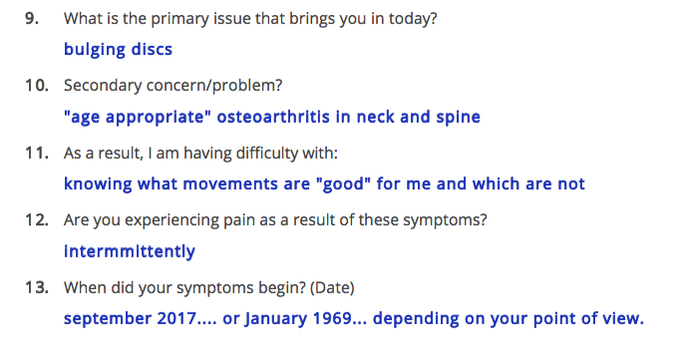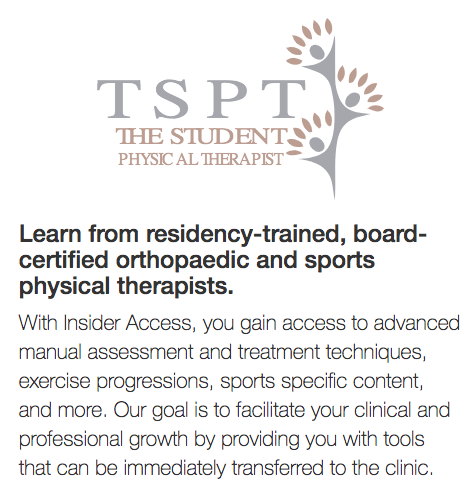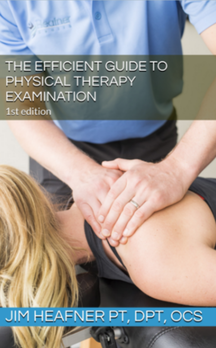- Home
- About Us
- TSPT Academy
- Online Courses
-
Resources
- Newsletter
- Business Minded Sports Physio Podcast
- Day in the Life of a Sports PT
- Residency Corner
-
Special Tests
>
-
Cervical Spine
>
- Alar Ligament Test
- Bakody's Sign
- Cervical Distraction Test
- Cervical Rotation Lateral Flexion Test
- Craniocervical Flexion Test (CCFT)
- Deep Neck Flexor Endurance Test
- Posterior-Anterior Segmental Mobility
- Segmental Mobility
- Sharp-Purser Test
- Spurling's Maneuver
- Transverse Ligament Test
- ULNT - Median
- ULNT - Radial
- ULNT - Ulnar
- Vertebral Artery Test
- Thoracic Spine >
-
Lumbar Spine/Sacroiliac Joint
>
- Active Sit-Up Test
- Alternate Gillet Test
- Crossed Straight Leg Raise Test
- Extensor Endurance Test
- FABER Test
- Fortin's Sign
- Gaenslen Test
- Gillet Test
- Gower's Sign
- Lumbar Quadrant Test
- POSH Test
- Posteroanterior Mobility
- Prone Knee Bend Test
- Prone Instability Test
- Resisted Abduction Test
- Sacral Clearing Test
- Seated Forward Flexion Test
- SIJ Compression/Distraction Test
- Slump Test
- Sphinx Test
- Spine Rotators & Multifidus Test
- Squish Test
- Standing Forward Flexion Test
- Straight Leg Raise Test
- Supine to Long Sit Test
-
Shoulder
>
- Active Compression Test
- Anterior Apprehension
- Biceps Load Test II
- Drop Arm Sign
- External Rotation Lag Sign
- Hawkins-Kennedy Impingement Sign
- Horizontal Adduction Test
- Internal Rotation Lag Sign
- Jobe Test
- Ludington's Test
- Neer Test
- Painful Arc Sign
- Pronated Load Test
- Resisted Supination External Rotation Test
- Speed's Test
- Posterior Apprehension
- Sulcus Sign
- Thoracic Outlet Tests >
- Yergason's Test
- Elbow >
- Wrist/Hand >
- Hip >
- Knee >
- Foot/Ankle >
-
Cervical Spine
>
- I want Financial Freedom
- I want Professional Growth
- I want Clinical Mastery
|
If you are looking to improve your clinical efficiency, a simple place to start is the intake paperwork. The intake forms often provide the patient's medical background, outcome measures, etc... AND hopefully gives a glimpse into the patient's own description of their symptoms. This is essentially a snapshot of their subjective history, which guides you into specific objective measures. In this post, I outline the power of language from the intake paperwork and my strategies to maximize my efficiency prior to EVER meeting the patient. The Power of LanguageA patient's language provides significant insight into the underlying cause of their problem. For example, if I am reviewing a new evaluation's paperwork for someone who has experienced chronic low back pain for the past 10 years, I am interested in their current thoughts about their systems. If the pain has been present for 10 years, what other interventions have they tried...? do they believe it can get better? If they perseverate on past surgeries, anatomical degeneration, their dog that passed away when they were young, and getting fired from a job 6 years ago, I can draw conclusions regarding biopsychosocial factors are influencing their low back pain. This same patient has likely uses language that reinforces their current symptomology. The language is engrained in the patient's neurology and likely includes thought viruses and f.e.a.r (false evidence appearing real). Thought Virus: “A thought virus is a negative or limiting belief. Often times, a thought virus is generalization or a misrepresentation that was once drawn from experience but is now inaccurate because of its separation from current context as well as evolution of knowledge and understanding. The danger in thought viruses is that, because they often contain some truth or they are partly true in some contexts, people are less likely to question their validity.” Heafner Health Intake QuestionsAs part of my intake paperwork at Heafner Health, I have all patients answer the questions below. With these questions, I want to know why someone is coming to see me, what activities they are unable to do, and approximately when their symptoms began. While I am looking at the objective data with each question, I am also investigating the specific language they use to describe their problem. Their answers provide insight into their perception of injury, fear avoidance to movement, and what they believe causes their issues. When someone answers the intake paperwork, I am merely trying to gather raw data that will then be confirmed or denied during the initial evaluation. Each question is a sliver of the entire pie that creates the framework of their current injury. Reviewing my questions above, here are my thoughts to the answers for a patient I treated a few weeks ago: Questions 9/10: What is the primary issue that brings you in today? This patient identifies his bulging discs as the primary issue that brings him into the clinic. Typically, when someone writes 'bulging discs,' I make a mental note to educate the patient regarding low back pain and disc degeneration as this is a common misconception. Specifically, I provide education in the form on an analogy. A common analogy I use for disc degeneration is the 'wrinkles on the inside' concept, which discusses that we age internally just as we age externally! Despite his anatomical answer to question 9, he acknowledges that his osteoarthritis is 'age appropriate' in question 10. I will still discuss disc degeneration, but hopefully it will be a welcomed conversation. Question 11: As a result, I am having difficulty with? This particular client is not having too much difficulty with specific activities, but rather wondering the difference between 'good' and 'bad' movements. His response is positive because likely he has a low level of overall irritability. Other patient's respond with detailed language that insinuates a fear of movement. Based on his response, I already anticipate a quick return to full activity. For question 11, my focus will be providing education on posture and movement. Newer studies on posture and pain, have demonstrated there are no 'good vs. bad movements.' My education would go as follows: "As humans beings we are designed to move. You have probably heard the quote 'movement is medicine.' It is absolutely true! All movements are great as long as our brain and body are adequately prepared for the movement! To live healthy lives, we must have the capability to explore the bad posture positions equally as well as we can perform the good postures." Question 12: This answer reaffirms his low level of irritability! I am good to proceed to Question 13. Question 13: When did your symptoms begin? This patient provides two answers to his onset of symptoms, either recently or decades ago. From his response, I can gather that he is experiencing a recent onset of a chronic injury. As someone who treats the neuromusculoskeletal system, I am interested in both answers. His older injuries and how he managed them will directly play into the management of this recent onset. Most importantly, I want to know how his January 1969 injury plays into his current symptoms. There must be a strong connection to his original injury if he reports the month the event began roughly 50 years ago! This answer is worth exploring in greater detail during the subjective interview. Closing ThoughtsThe words we use and how we use them have an immeasurable impact on a patient. If ‘thought viruses’ have the potential to worsen a patient’s prognosis, the opposite must also be true. Learning to evaluate a patient's language even before they arrive at your clinic can prepare you for the upcoming evaluation. As health and wellness providers, the ability to understand someone’s needs, and tailor one’s language toward these needs, can significantly influence the outcome of their situation . Author: Jim Heafner PT, DPT, OCS More from The Student Physical Therapist
0 Comments
Leave a Reply. |
Dr. Brian Schwabe's NEW Book in partner with PaleoHacks!
Learn residency-level content on our
Insider Access pages We value quality PT education & CEU's. Click the MedBridge logo below for TSPT savings!Archives
July 2019
Categories
All
|










 RSS Feed
RSS Feed